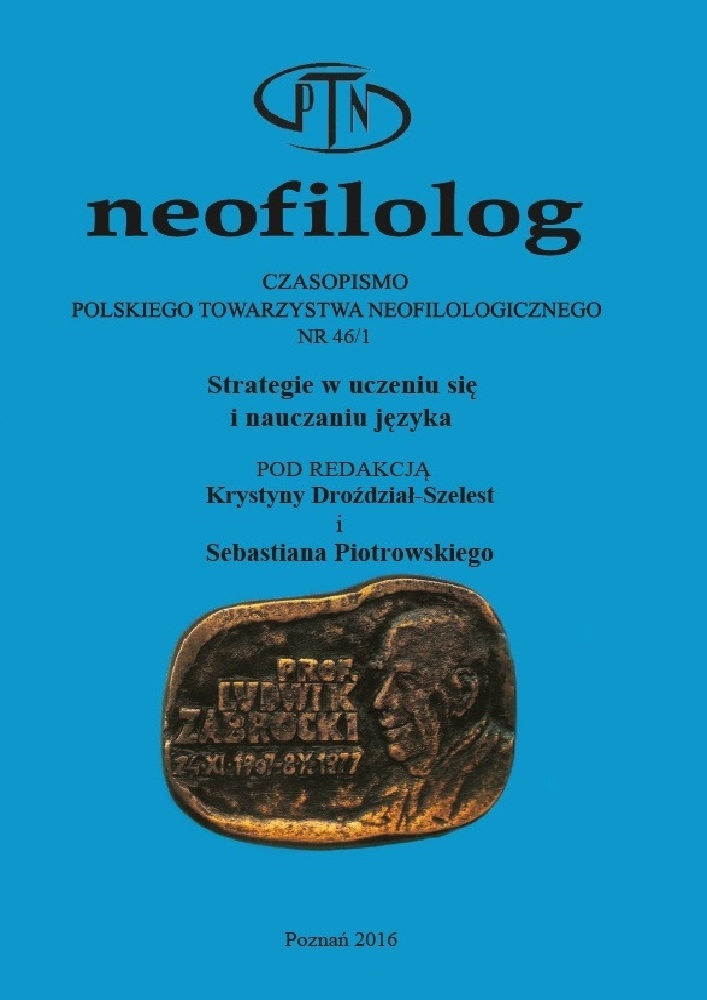Abstract
Although language learning strategies are a well-researched topic, there are still some aspects which need further investigation and one of these is the application of strategic devices in the second and third language. The following article seeks to compare how learners of two foreign languages use strategies and shows both differences and similarities between the application of strategic devices by presenting the results of a research project in which a questionnaire and an interview were used as the research tools. Strategies were found to be used more often when learning the L2 than during the process of learning the L3. Dissimilarities were observed in the specific types of strategies used, especially in the case of metacognitive strategies, while similarities were noted in the use of affective strategies.
References
Cohen, A.D. i Chi, J.C. 2002. “Language strategy use inventory and index”. (w) Maximiz-ing Study Abroad (red. Paige, R.M., Cohen, A.D., Kappler, B., Chi, J.C. i Lassegard, J.P.). Minneapolis: Center for Advanced Research for Language Acquisition, Uni-versity of Minnesota: 16-28.
Cohen, A. D. 2014. Strategies in Learning and Using a Second Language. Abingdon: Routlege.
Dörnyei, Z. i Shekan, P. 2003: “Individual differences in second language learning” (w) The Handbook of Second Language Acquisition. (red. Doughty, C. i Long, M.). Oxford: Blackwell: 589-630.
Dörnyei, Z. 2005. The Psychology of the Language Learner: Individual Differences in Second Language Acquisition. Mahwah, New York: Lawrence Erlbaum.
Dörnyei, Z. 2007. Research Methods in Applied Linguistics. Oxford: Oxford University Press.
Ellis, R. 2004. “Individual differences in second language learning” (w) The Handbook of Applied Linguistics (red. Davies, A. i Elder, C.). Oxford: Blackwell: 525–551.
Gi-Pyo, P. 2011. “The validation process of the SILL: a confirmatory factor analysis”. English Language Teaching 4: 21-27.
Griffiths, C. 2008. “Strategies and good language learners” (w) Lessons form Good Language Learners (red. Griffiths, C.). Cambridge: Cambridge University Press: 83-98.
Griffiths, C. i Oxford, R. 2014. “The twenty-first century landscape of language learning strategies: introduction to this special issue”. System 43: 1-10.
Korkmaz, Ş.Ç. 2013. “Third language learning strategies of ELT learners studying either German or French”. Hacettepe Ȕniversitesi Eḡitim Fakültesi Dergisi Journal of Education 28: 92-104.
Mißler, B. 2000. “Previous experience of foreign language learning and its contribution to the development of learning strategies” (w) Tertiär – und Drittsprachen: Pro-jekte und empirische Untersuchungen (red. Dentler, S., Hufeisen, B. i Lindemann, B.). Tübingen: Stauffenburg: 7-22.
Naiman, N., Fröhlich, M., Stern, H.H. i Todesco, A. (1995). The Good Language Learner. Clevedon: Multilingual Matters.
O’Malley, J. i Chamot, A. 1990. Learning Strategies in Second Language Acquisition. Cambridge: Cambridge University Press.
Oxford, R. 1990. Language Learning Strategies: What Every Teacher Should Know. Boston: Heinle & Heinle.
Oxford, R. 1999. “Learning strategies”. (w) Concise Encyclopedia of Educational Lin-guistics (red. Spolsky, B.). Oxford: Elsevier: 518-522.
Oxford, R. 2003. “Language learning styles and strategies: an overview”. Learning Styles & Strategies/ Oxford, GALA: 1-25.
Pawlak, M. 2011. “Research into language learning strategies: Taking stock and looking ahead” (w) Individual Learner Differences in SLA (red. Arabski, J. i Wojtaszak, A.). Clevedon: Multilingual Matters: 17-37.
Purpura, J. 1999. Learner Strategy Use and Performance on Language Tests: A Struc-tural Equation Modeling Approach. Cambridge: Cambridge University Press.
Rose, H. 2012. “Language learning strategy research: Where do we go from here?”. Studies in Self-Access Learning Journal 3: 137-148.
Rubin, J. 1975. “What the ‘Good Language Learner’ can teach us”. TESOL Quarterly 9: 41-51.
Stern, H. 1975. “What can we learn from the good language learner?”. Canadian Mod-ern Language Review 31: 304-318.
Weinstein, C. i Mayer, R. 1986. “The teaching of learning strategies” (w) Handbook of Research on Teaching (red. Wittrock, M.C.). New York: Macmillan: 315-327.
License
Copyright (c) 2018 Zuzanna Kiermasz

This work is licensed under a Creative Commons Attribution-NoDerivatives 4.0 International License.
Authors
Authors of texts accepted for publication in Neofilolog are required to complete, sign and return to the Editorial team’s office the Agreement for granting a royalty-free license to works with a commitment to grant a CC sub-license.
Under the agreement, the authors of the texts published in Neofilolog grant Adam Mickiewicz University in Poznań a non-exclusive, royalty-free license and authorize the use of Attribution-NoDerivatives 4.0 International (CC BY-ND 4.0) Creative Commons sub-license.
The authors retain the right to the free disposal of the work.
Users
Interested Internet users are entitled to use works that have been published in Neofilolog since 2017, under the following conditions:
▪ attribution – obligation to provide, together with the distributed work, information about the authorship, title, source (link to the original work, DOI) and the license itself.
▪ no derivatives – the work must be preserved in its original form. Without the author's consent, it is not possible to distribute the modified work in the form of translations, publications, etc.
Copyrights are reserved for all texts published since 2017.
Miscellaneous
Adam Mickiewicz University in Poznań retains the property right as a whole (layout, graphic form, title, cover design, logo etc.).
